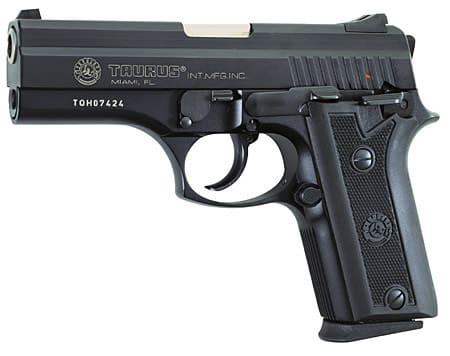I’m thinking that John Aaron Norris didn’t mean to shoot his wife with a Taurus 911. For the sake of argument, let’s assume Mrs. Norris died in a horrible accident and consider the circumstances surrounding her untimely end. sanluisobispo.com reports:
Norris said that as he was handling a gun in the living room — a Taurus 911 pistol — he tripped over a dog. He said he had the gun in the room because a neighbor with mental problems had recently walked inside his family’s home uninvited and it made him paranoid.
Norris said he squeezed the trigger as he clenched his fist to brace himself for the fall. He said the gun fired and the bullet struck his wife, who was sitting on a sofa nearby.
If you join me in my assumption that this was a negligent discharge, you might think it a freak accident. Yes and no.
When the Federal Aviation Administration and the National Transportation Safety Board investigate horrific airplane crashes, they aren’t looking for the smoking gun: the one fatal mistake that led to the carnage. They know most accidents involve a series of mistakes.
Whether examining a mechanical malfunction or a terrorist bomb, they’re exploring a chain of events that led to disaster. Change any one of those contributory events, and the accident might have never have happened.
In fact, airplane accidents are avoided. Routinely. Someone in the chain catches an “issue” before it can leave the door open to the possibility of another failure. Leading to catastrophe.
The same holds true for firearms. Owners catch initial safety problems—such as a round left in the chamber—all the time. They take corrective action and all’s well.
And sometimes they don’t. And then problems begin to compound. An unseen countdown to tragedy begins. In this case, I reckon training was safety failure number one.
Deputy District Attorney Matt Kerrigan said in his opening statements that Norris was an active military man who was trained in using guns.
All U.S. soldiers receive rifle training. Handguns? Not so much.
The U.S. military issues Beretta M9 and Sig-Sauer P226 (a.k.a M11) to high-ranking soldiers and some of those heading to the sandbox (e.g. MPs, Chaplains, Special Forces). It’s highly likely that the military trained Norris in the care and feeding of handguns.
It’s also questionable whether or not Norris knew how to carry and fire a “1911-style” Taurus 911. Many gun owners only purchase a handgun after they become aware of a specific threat. Given that this homicide occurred around the time the wandering nutcase entered Norris’ home, it’s entirely possible he had very little training time on the Taurus 911.
Let’s drill down on that a bit:
[DA] Kerrigan said that safety features on the handgun could have prevented the shooting, including a safety device on the grip that engages when a person holds it by the handle.
Another safety switch on the gun has to be turned off to allow the gun to fire, Kerrigan said. The pistol also has to be cocked to fire, the prosecutor added.
When you rack the slide to load a cartridge into the 911’s chamber, it automatically cocks the hammer. The aforementioned grip safety prevents the hammer from falling unless there’s a hand holding the weapon. (You have to grip the gun to make it go bang.) A racked 911 is said to be “cocked and locked.”
Unless you de-cock the 911’s hammer (i.e. return it to rest) using the lever provided for that purpose, the weapon is in single action mode. Hammer forward. Bang. One action. In this state, the trigger pull is very light.
In contrast, the military’s M9 and M11 handguns are double action only weapons. Hammer back. Hammer forward. Double action. The trigger pulls is always [relatively] heavy, to help prevent negligent discharges.
Did Norris know to de-cock his 911? It’s not as easy as it sounds. The 911 has a three-position safety: safe, fire and de-cock. Not a separate de-cocking lever. Also, did Norris know that that the 911 has a light trigger pull?
The 911 has a thumb-activated safety. No doubt Norris was aware of the device (it’s kinda hard to miss). BUT—if Norris wasn’t proficient in carrying and shooting a 911, he may have worried that he’d forget to switch off the safety at the critical moment. Either that or he left the safety off to increase the weapon’s state of readiness. Either way, good training would have taught him to keep the safety on until he was ready to fire.
Bottom line: Norris could have carried the 911 without a bullet in the chamber [hammer uncocked). He could have put one in the pipe and de-cocked the hammer. The thumb safety could have been engaged. Or he could have chosen a double action weapon like a revolver. Any of these choices would have dramatically reduced the chances of a negligent discharge.
Which brings us to contributory factor number two: Norris’ mental state.
While we can understand that a previous home invasion by a mentally unstable individual made Norris fear for his life, exactly how frightened was he? Given the circumstances, the word “paranoid” is more than slightly odd. Clearly, Norris is admitting that he had a great deal of fear. Less clearly, he’s intimating that it was disproportionate to the actual threat.
Why was Norris holding a gun, ready to rock and roll, at the time of the shooting? Was Norris responding to a specific stimulus, or was he walking around with the Taurus 911 in his hand during every waking hour (a sign of genuine paranoia)?
Make no mistake: extreme fear is a dangerous thing.
Initially, the adrenalin dump raises capabilities. After a while, it significantly degrades them. Over an extended period of time, bad things happen, including sleep deprivation-related psychosis.
Norris could have taken other, non-firearms steps to reduce the threat before he’d lost psychological equilibrium. Did Norris drop the dime on the perp? Did he try to determine if the threat had been reduced/eliminated (i.e. a shrink had put the nutcase in a rubber room)? Did Norris harden his home’s security systems and upped awareness amongst inhabitants, to make sure that there’d be no more of that wandering-in nonsense?
Any of these actions may have allowed him the mental distance needed to relax, as well as a safe physical distance from a dangerous weapon.
At the same time, extended fear would have made Norris both inattentive and clumsy. Hence his lack of awareness of the dog’s location or ability to avoid contact.
It’s also possible that Norris was NOT afraid. Maybe he was too casual. If so, he wouldn’t be the first yutz to walk around with a loaded gun in his hand with no more thought than a plate of pastrami (in all senses).
Anyway you cut it, Norris was not in the right mental state for home defense: wary but relaxed, ready to adjust readiness in synch with the actual threat level.
Contributory factor number three: trigger discipline.
Norris said he squeezed the trigger as he clenched his fist to brace himself for the fall. He said the gun fired and the bullet struck his wife, who was sitting on a sofa nearby.
It’s entirely possible that Norris fired the fatal shot by clenching his non-firing hand. During stress, the para-sympathetic nervous system often causes both hands to squeeze simultaneously, regardless of the shooter’s conscious command. (Quite why you would clench a fist to break your fall is another matter.)
Does it matter? If Norris had kept his finger off the trigger, his wife might still be alive.
Contributory factor number four: muzzle discipline.
Provided there isn’t anyone beneath you (e.g. in the basement), the proper way to carry a weapon is muzzle down. Straight down. If Norris had held the gun in that attitude, it would have been safe during his stumble trip. Also, any gun owner in his right mind (not a given, obviously) should have the psychological wherewithal to maintain muzzle disciple, even mid-fall.
With a bit of luck and some good lawyering, the jury in the Norris manslaughter case will consider all of these factors (along with facts). But they will not bring Mrs. Norris back to life. The best way to avoid the need for resurrection: avoid tragedy in the first place. Put gun safety first. Last. And, crucially, in the middle.





As I've taught my kids, never never never put your finger inside the trigger guard until ready to fire. Not when carrying the gun, not when loading, not when adjusting the scope (or sights), not when adjusting sandbags, not when fidgiting in the chair or eyeballing the target, but only just immediately right before you intend to fire. Otherwise, your finger is outside the trigger guard and away from the trigger. Clinching your fist under stress is a hardwired reaction that can happen subconsciously.
Of course, one time I slide off the road drag racing my Dad's car and scraped up the side. I blamed that one on a cat. He blames this on a dog. No telling what really happened here.
Comments are closed.